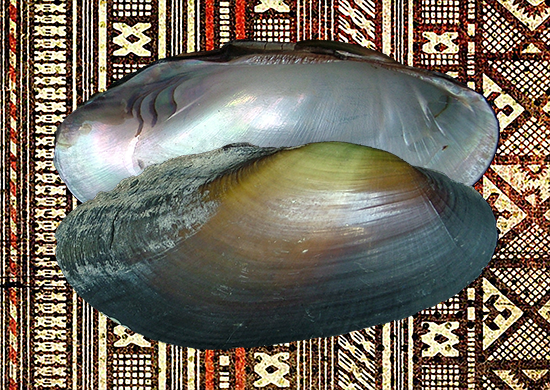| Page last updated
7 October 2022 |
Mussel of the Month
The October 2022 Mussel of the Month is Pleiodon spekii. Pleiodon is a genus of two species endemic to Africa.

MNHN. Lake Tanganyika. (type of Cameronia marioniana Bourguignat, 1886)
|
Pleiodon is a genus of the freshwater mussel family Iridinidae (Mutelidae is a junior synonym, although the name is still sometimes found in the literature). The family is currently divided between two subfamilies: the Iridininae (with includes Pleiodon) and the Aspathariinae. Graf & Cummings (2006) performed a morphology-based phylogenetic analysis with representatives of both subfamilies and reported four synapomorphies of the family clade:
- a well-developed pedal elevator scar under each umbo,
- formation of the mantle of the excurrent aperture into a tubular siphon,
- lasidium type larvae that are released within a durable egg capsule, and
- larvae that attach via tubular appendages (i.e., forming an haustorium).
At the time, the iridinid larval condition was extrapolated from the observations of a single species in the genus Mutela. Since then, the data are not much more complete. Morad et al. (2018) recently described the eggs and larvae of Chambardia rubens (subfamily Aspathariinae), and their discussion did not contradict the status quo.
However, subsequent analyses based on nuclear and mitochondrial DNA have consistently failed to recover a monophyletic Iridinidae. The subfamilies seem to hold up, although the Iridininae has only been represented in such studies by the genus Mutela. The inclusion of Pleiodon and Chelidonopsis in the same clade is supported by their shared possession of well-developed incurrent and excurrent siphons. Genera of the Aspathariinae (Aspatharia and Chambardia) only have an excurrent siphon with a more open incurrent aperture.
As summarized on the Iridinidae Cladomics page, some analyses have found that the Aspathariinae share a more recent common ancestor with the family Mycetopodidae than with the Iridininae (Walker et al., 2006; Lopes-Lima et al., 2017). Other studies have found a closer relationship between the Mycetopodidae and the Iridininae (Whelan et al., 2011; Combosch et al., 2017), and others have found a mixed pattern (Huang et al., 2019). This discrepancy is made all the more interesting by the fact that these studies are largely re-analyzing the same data!
In the absence of a robust result and a new set of morphological synapomorphies on which we could hang a classification, we continue to recognize the "Iridinidae" with an openness to future revision. |
|
Classification:
Phylum Mollusca
Class Bivalvia
Subclass Palaeoheterodonta
Order Unionoida
Superfamily ETHERIOIDEA Deshayes, 1830
Family "Iridinidae" Swainson, 1840
Subfamily "Iridininae" s.s.
Genus Pleiodon Conrad, 1834
Species Pleiodon spekii (Woodward, 1859) |
To find out more about Pleiodon and the phylogeny of the Iridinidae, check out:
- Combosch, D.J., T.M. Collins, E.A. Glover, D.L. Graf, E.M. Harper et al. 2017. A family-level tree of life for bivalves based on a Sanger-sequencing approach. Molecular Phylogenetics and Evolution 107: 191-208.
- Graf, D.L. & K.S. Cummings. 2006. Palaeoheterodont diversity (Mollusca: Trigonioida + Unionoida): what we know and what we wish we knew about freshwater mussel evolution. Zoological Journal of the Linnean Society 148: 343-394.
- Huang, X.-C., J.-H. Su, J.-X. Ouyang, S. Ouyang, C.-H. Zhou & X.-P. Wu. 2019. Towards a global phylogeny of freshwater mussels (Bivalivia: Unionida): Species delimitation of Chinese taxa, mitochondrial phylogenomics, and diversification patterns. Molecular Phylogenetics and Evolution 130: 45-59.
- Lopes-Lima, M., E. Froufe, V.T. Do, M. Ghamizi, K.E. Mock et al. 2017. Phylogeny of the most species-rich freshwater bivalve family (Bivalvia: Unionida: Unionidae): Defining modern subfamilies and tribes. Molecular Phylogenetics and Evolution 106: 174-191.
- Morad, M., M.F. Fol, I.S. Gamil & R.M. Mansour. 2018. Gonad variation and development of freshwater Chambardia rubens Lamarck, 1819 (Bivalvia: Mutelidae) from the River Nile in Egypt. Journal of Bioscience and Applied Research 4(4): 495-506.
- Walker, J.M., J.P. Curole, D.E. Wade, E.G. Chapman, A.E. Bogan & W.R. Hoeh. 2006. Taxonomic distribution and phylogenetic utility of gender-associated mitochondrial genomes in the Unionoida (Bivalvia). Malacologia 48(1-2): 265-282.
- Whelan, N.V., A.J. Geneva & D.L. Graf. 2011. Molecular phylogenetic analysis of tropical freshwater mussels (Mollusca: Bivalvia: Unionoida) resolves the position of Coelatura and supports a monophyletic Unionidae. Molecular Phylogenetics and Evolution 61: 504-514.

|